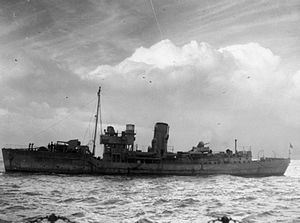 HMS Periwinkle, October 1941 HMS Periwinkle, October 1941
| |
| History | |
|---|---|
| Name | HMS Periwinkle |
| Namesake | Periwinkle (flower) |
| Builder | Harland & Wolff, Belfast |
| Laid down | 30 October 1939 |
| Launched | 24 February 1940 |
| Commissioned | 8 April 1940 |
| Decommissioned | 15 March 1942 |
| Identification | Pennant number: K55 |
| Fate | Transferred to United States Navy |
| Name | USS Restless |
| Commissioned | 15 March 1942 |
| Decommissioned | 20 August 1945 |
| Identification | Hull number: PG-66 |
| Fate | Returned to Royal Navy |
| Name | HMS Periwinkle |
| Fate | Sold into civilian service 1947, scrapped 1953 |
| General characteristics | |
| Class and type | Flower-class corvette |
| Displacement | 925 long tons (940 t; 1,036 short tons) |
| Length | 205 ft (62.48 m)o/a |
| Beam | 33 ft 2 in (10.11 m) |
| Draught | 13 ft 7 in (4.14 m) |
| Propulsion |
|
| Speed | 16.5 knots (30.6 km/h) |
| Range | 3,500 nautical miles (6,482 km) at 12 knots (22.2 km/h) |
| Complement | 85 |
| Sensors and processing systems |
|
| Armament |
|
HMS Periwinkle was a Flower-class corvette, built for the Royal Navy during the Second World War, and was in service in the Battle of the Atlantic. In 1942 she was transferred to the United States Navy as part of the Reverse Lend-Lease arrangement and renamed USS Restless, one of the Temptress-class gunboats. With the end of hostilities she was returned to the Royal Navy and sold into mercantile service.
Design and construction
Periwinkle was built at Harland & Wolff, Belfast, as part of the 1939 War Emergency building programme. She was laid down on 30 October 1939 and launched 24 February 1940. She was completed and entered service on 8 April 1940, being named for the periwinkle family of flowers. As built, Periwinkle had the short forecastle that was a feature of the early Flowers, and which adversely effected their habitability. She also had the merchant-style enclosed wheelhouse, and the foremast stepped ahead of the bridge, of the original design.
Service history
Royal Navy
After working up, Periwinkle was assigned to the Western Approaches Escort Force for service as a convoy escort. In this role she was engaged in all the duties performed by escort ships; protecting convoys, searching for and attacking U-boats which attacked ships in convoy, and rescuing survivors. In 23 months of service, Periwinkle escorted 41 North Atlantic, 10 Gibraltar and 10 South Atlantic convoys assisting in the safe passage of over 1500 ships. She was involved in three major convoy battles: In September 1940 Periwinkle was part of the escort for convoy SC 2, which was attacked by a U-boat pack, losing 5 ships sunk. In October 1940 she was with HX 77, which lost six ships sunk. On 14 October 1940 Periwinkle and the destroyer HMCS Skeena rescued 220 members of the crew of HMS Cheshire, which U-137 had damaged by torpedo. In June 1941 Periwinkle was with OB 329, which saw four ships and U-147 sunk; Periwinkle and HMS Wanderer shared in the U-boat's sinking. In September 1941 she was with HG 73, which lost nine merchant and one warship sunk.
US Navy
For other ships with the same name, see USS Restless.Following the entry of the United States into the war, the US Navy was in need of anti-submarine warfare vessels, and to meet this need a number of ships were transferred from the Royal Navy as part of a reverse Lend-Lease arrangement. Periwinkle was commissioned into the USN on 15 March 1942 as USS Restless. After an overhaul Restless was employed as an escort on convoys between New York and the Caribbean. In August 1945 she was decommissioned and returned to the Royal Navy.
Fate
Periwinkle was stricken in 1947 and sold into commercial service as the merchant ship Perilock. She was scrapped at Hong Kong in 1953.
Notes
- Conway p62
- Elliott p.187
- Periwinkle: convoy movements at naval-history.net; retrieved 18 July 2020
- Periwinkle: convoy assignments at convoyweb.org.uk; retrieved 18 July 2020
- Blair p.182
- Blair p.197
- Helgason, Guðmundur. "HMS Cheshire (F 18)". Ships hit by U-boats. Retrieved 9 January 2024.
- Blair p.307
- Kemp p.70
- Blair pp.389-391
- Elliott p189
- ^ Restless at history.navy.mil; retrieved 18 July 2020
- Periwinkle at uboat.net; retrieved 18 July 2020
References
- Blair, Clay (2000). Hitler's U-Boat War: The Hunters 1939–1942. London: Cassell. ISBN 0-304-35260-8.
- Chesneau, Roger, ed. (1980). Conway's All the World's Fighting Ships 1922–1946. Greenwich, UK: Conway Maritime Press. ISBN 0-85177-146-7.
- Elliott, Peter (1977). Allied Escort Ships of World War II: A complete survey. London: Macdonald and Jane's. ISBN 0-356-08401-9.
- Hague, Arnold (2000). The Allied Convoy System 1939–1945. ISBN 1-55125-033-0 (Canada); ISBN 1-86176-147-3 (UK)
- Kemp, Paul (1997). U-Boats Destroyed, German submarine losses in the World Wars. Arms and Armour. ISBN 1-85409-515-3.